
Concept explainers
(a)
Interpretation:
How UV-vis spectroscopy could be used to determine whether the given reaction has actually taken place or not is to be suggested with reason.
Concept introduction:
Compounds with lone pairs tend to have longer-wavelength absorptions than analogous compounds without lone pairs. The longest
Answer to Problem 15.36P
The given reaction will take place as suggested by change in the
Explanation of Solution
The given reaction is:
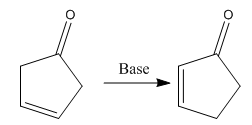
In the above reaction, both the reactant and product have two double bonds; in the product, both double bonds are in conjugation, but in the reactant, they are not.
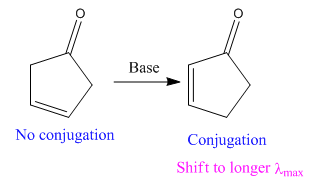
Thus, we can say that the given reaction has actually occurred.
Whether the given reaction has actually taken place is suggested on the basis of conjugation in the product and its effect on
(b)
Interpretation:
How UV-vis. Spectroscopy could be used to determine whether the given reaction has actually taken place or not is to be suggested with reason.
Concept introduction:
Compounds with lone pairs tend to have longer-wavelength absorptions than analogous compounds without lone pairs. The longest
Answer to Problem 15.36P
The given reaction does not occur as given, since the
Explanation of Solution
The given reaction is:

In the above reaction, the reactant has two double bonds in conjugation, and the product has only one double bond. Thus,
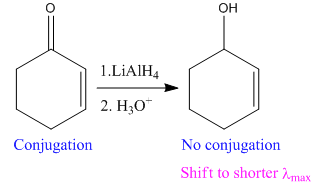
Thus, we can say that the given reaction does not take place.
Whether the given reaction has actually taken place is suggested on the basis of conjugation in the product and its effect on
(c)
Interpretation:
How UV-vis. Spectroscopy could be used to determine whether the given reaction has actually taken place or not is to be suggested with reason.
Concept introduction:
Compounds with lone pairs tend to have longer-wavelength absorptions than analogous compounds without lone pairs. The longest
Answer to Problem 15.36P
The given reaction not take place as given, since the
Explanation of Solution
The given reaction is:
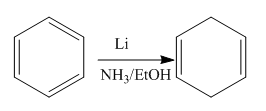
In the above reaction, the reactant has three double bonds in conjugation, and the product has two double bonds not in conjugation. The value of the longest-wavelength

Thus,
Whether the given reaction actually took is suggested on the basis of conjugation in the product and its effect on
(d)
Interpretation:
How UV-vis. Spectroscopy could be used to determine whether the given reaction has actually taken place or not is to be suggested with reason.
Concept introduction:
Compounds with lone pairs tend to have longer-wavelength absorptions than analogous compounds without lone pairs. The longest
Answer to Problem 15.36P
The given reaction will take place as suggested by change in the
Explanation of Solution
The given reaction is:

In the above reaction, both reactant and product have three triple bonds in conjugation, but the reactant has a lone pair. So, the reactant’s longest-wavelength absorption corresponds to a
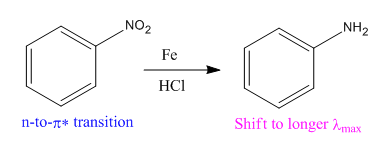
Therefore the
Whether the given reaction actually took is suggested on the basis of conjugation in the product and its effect on
(e)
Interpretation:
How UV-vis. Spectroscopy could be used to determine whether the given reaction actually took is to be suggested with reason.
Concept introduction:
Compounds with lone pairs tend to have longer-wavelength absorptions than analogous compounds without lone pairs. The longest
Answer to Problem 15.36P
The given reaction will take place as suggested by change in the
Explanation of Solution
The given reaction is:

In the above reaction, the reactant has three conjugated bonds, and the product has four conjugated double bonds.
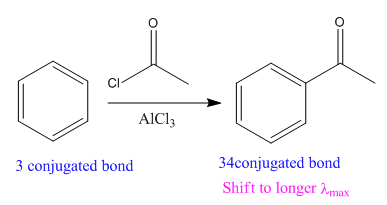
Thus, we can say that the given reaction is actually took place.
Whether the given reaction actually took is suggested on the basis of conjugation in the product and its effect on
Want to see more full solutions like this?
Chapter 15 Solutions
EBK GET READY FOR ORGANIC CHEMISTRY
- Need help on the following please.arrow_forwardAt each wavelength, the Beer-Lambert equation states that absorbance is proportional to concentration. For quantitative concentration estimations, any wavelength might theoretically be used. However, we usually choose the wavelength with the highest absorbance for a specific sample and utilize that in our absorbance measurements. The steeper parts of the spectrum should be avoided. Why?arrow_forwardWhich molecule, HCl or HBr will have a higher energy IR absorption? Explain. (Hint, the spring force constant for the bonds in these two molecules are similar.)arrow_forward
- IR and UV-Vis spectroscopy are similar methods in theory but are substantially different. What is the difference between the techniques and how does this impact what they are used for?arrow_forwardDraw structures for the three isomers 1-butyne, 1,3-butadiene, and 2-butyne. Explain how you would distinguish these compounds using IR spectroscopy. Give specific examples of peaks that would illustrate the differences.arrow_forwardYou are doing a ruthenium catalyzed hydrogenation of 4-methylbenzaldehyde (reactant) to 4-methylbenzyl alcohol (product). Draw the reaction equation. Can you use IR spectroscopy to distinguish between reactant and product? Include a detailed list of the characteristic IR bands that you expect to see in your explanation.arrow_forward
- In this activity, you will begin to use IR spectroscopy to examine functional groups in organic molecules. First, thinking about what an IR spectrum looks like... An IR spectrum is a most often a plot of... ✓ Choose... wavenumver vs absorbance absorbance vs wavelength transmittance vs wavenumber signal amplitude vs ppmarrow_forwardHow can you distinguish aldehydes, ketones, and carboxylic acids from each other using IR spectra? Explain using specific examples.arrow_forwardQ8. How would you distinguish the following molecules using IR and Mass Spectrometry? Please label at least two differences for IR and two for MS. Please draw the mechanism for the formation of fragments which can distinguish the two molecules via mass spectrometry. HOarrow_forward
- Can you explain spectroscopy? Let's start with NMR Spectroscopy. What is the difference between a proton being enantiotopic and homotopic? What does it mean for a proton to be shielded or deshielded? How do you determine J (the coupling constant)? What does 'coupling is mutual' mean? How is that translated on the NMS Spectroscopy spectrum? Does that have to do with the polarity of the molecule? Is there an easier way to explain that? When thinking about C-13 NRM Spectroscopy, what it meant by the statement, "the carbons cannot integrate"? When looking at an NMR Spectroscopy spectrum, how do you know which peak belongs to which proton? (The intensity of the peak and the ppm of the peak) P.S. These questions come from after watching a lecture. There is no graded assignment attached to these questions. I simply do not understand the material.arrow_forwardA student has acquired an IR spectra of an unknown six-carbon molecule and has determined that it is either 2-hexyne, 1- hexyne, or 1-hexene. How can the student use their knowledge of IR spectroscopy to determine the identity of the molecule? In your answer, clearly specify what regions of the IR spectrum the student should look at and what bonds are responsible for the absorption bands you indicate.arrow_forwardPlease fix this for mearrow_forward
 Organic Chemistry: A Guided InquiryChemistryISBN:9780618974122Author:Andrei StraumanisPublisher:Cengage Learning
Organic Chemistry: A Guided InquiryChemistryISBN:9780618974122Author:Andrei StraumanisPublisher:Cengage Learning

